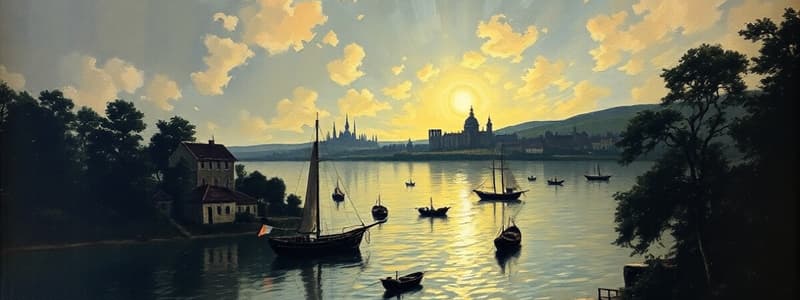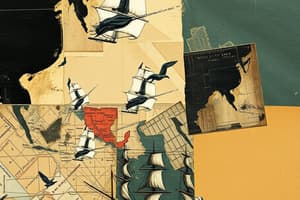Podcast
Questions and Answers
Which of the following best describes the initial Spanish strategy for establishing control over territories in the Caribbean?
Which of the following best describes the initial Spanish strategy for establishing control over territories in the Caribbean?
- Rapid military conquest followed by the implementation of economic systems like the Encomienda. (correct)
- Establishing free trade agreements to gain economic influence before military intervention.
- Focusing on diplomatic negotiations with indigenous leaders to secure land rights.
- Prioritizing religious conversion and cultural assimilation before any form of governance.
What primary challenge did the Spanish face in colonizing Trinidad, differentiating it from other Caribbean islands?
What primary challenge did the Spanish face in colonizing Trinidad, differentiating it from other Caribbean islands?
- Lack of valuable natural resources, making it an unattractive target for colonization.
- Frequent pirate attacks that disrupted colonization efforts.
- Geographic inaccessibility due to its distance from other Spanish colonies.
- Unified resistance from the Taino and Kalinago populations. (correct)
How did the Spanish utilize Jamaica differently compared to other colonies in the Greater Antilles?
How did the Spanish utilize Jamaica differently compared to other colonies in the Greater Antilles?
- As the main naval base for controlling the Caribbean Sea.
- For large-scale sugar production using advanced irrigation techniques.
- As a major hub for silver mining operations.
- Primarily for cattle ranching and farming due to its agricultural suitability. (correct)
What role did individuals like Hernan Cortes and Francisco Pizarro play in expanding the Spanish American Empire?
What role did individuals like Hernan Cortes and Francisco Pizarro play in expanding the Spanish American Empire?
Which of the following best illustrates the strategic importance of Trinidad to the Spanish Empire?
Which of the following best illustrates the strategic importance of Trinidad to the Spanish Empire?
Which of the following best describes the core principle of mercantilism as practiced during the 16th to 18th centuries?
Which of the following best describes the core principle of mercantilism as practiced during the 16th to 18th centuries?
What was the primary purpose of the Laws of Burgos, issued in 1512, concerning the Spanish American colonies?
What was the primary purpose of the Laws of Burgos, issued in 1512, concerning the Spanish American colonies?
How did the New Laws of the Indies (1542) differ from the Laws of Burgos in their intent and outcome?
How did the New Laws of the Indies (1542) differ from the Laws of Burgos in their intent and outcome?
What was the function of the 'Flota' system within the Spanish Empire's economic structure?
What was the function of the 'Flota' system within the Spanish Empire's economic structure?
How did privateering contribute to the conflicts between Spain and other European powers in the Americas?
How did privateering contribute to the conflicts between Spain and other European powers in the Americas?
What distinguished a 'privateer' from a 'pirate' during the era of Spanish colonization in the Americas?
What distinguished a 'privateer' from a 'pirate' during the era of Spanish colonization in the Americas?
How did the concept of a 'monopoly' relate to Spain's control over its Spanish American empire?
How did the concept of a 'monopoly' relate to Spain's control over its Spanish American empire?
Which of the following best describes the function of the 'Asiento' within the context of the Spanish colonial system?
Which of the following best describes the function of the 'Asiento' within the context of the Spanish colonial system?
Flashcards
Colonisation
Colonisation
Establishing control over indigenous people of an area. Often involves settlement and exploitation.
Mercantilism
Mercantilism
Economic system where a nation's wealth is based on increasing exports and accumulating precious metals.
Asiento
Asiento
A contract granted by the Spanish crown to other European powers or companies for a monopoly on providing African slaves to the Spanish colonies.
Privateers
Privateers
Signup and view all the flashcards
Flota
Flota
Signup and view all the flashcards
Galleons
Galleons
Signup and view all the flashcards
Empire
Empire
Signup and view all the flashcards
Monopoly
Monopoly
Signup and view all the flashcards
Encomienda System
Encomienda System
Signup and view all the flashcards
Hispaniola
Hispaniola
Signup and view all the flashcards
Puerto Rico
Puerto Rico
Signup and view all the flashcards
Cuba
Cuba
Signup and view all the flashcards
Mexico
Mexico
Signup and view all the flashcards
Study Notes
- Colonisation: The process of establishing control over indigenous people of an area.
- Mercantilism: An economic system of trade from the 16th to 18th century, based on increasing exports to enhance a nation's wealth and power.
- Asiento: Not defined in the text.
- Privateers: Armed ships owned by private individuals authorized by a government commission for wartime use, especially to capture merchant ships.
- Flota: Not defined in the text.
- Galleons: Sailing ships used especially by Spain from the 15th to 18th century, initially as warships and later for trade.
- Piracy: Not defined in the text.
- Privateering: Noun form of privateer.
- Empire: An extensive group of states or countries ruled by a single monarch, oligarchy, or sovereign state.
- Monopoly: Exclusive possession or control of the supply of or trade in a commodity or service.
- Colonist: A settler or inhabitant of a colony.
- Settlement: A colony or small community where people can reside.
- Laws of Burgos: Issued in 1512 by Ferdinand II to regulate relations between Spaniards and conquered Indians, aiming to ensure their spiritual and material welfare.
- New Laws of the Indies: (1542) of Charles I, sought to correct the inadequacies of the previous code
Establishment of the Spanish American Empire
- Government structure, economy, and church were established in the new territories by the Spanish.
- Conquest was the mode of establishing the Spanish Empire
Conquests in the Americas
- Hispaniola: Conquered by 1495 under the Columbus brothers; Nicolas de Ovando implemented the Encomienda System (1502-1508) for sugar, tobacco, and gold production.
- Puerto Rico: Conquered by Ponce de Leon in 1508.
- Cuba: Diego Velasquez exterminated the Taino; used for sugar, beef, and agricultural production.
- Jamaica: Conquered by Juan de Esquivel; used for cattle ranching and farming, considered less significant than other Greater Antilles colonies.
- Trinidad: Colonised by Josef de Oruna after fierce resistance from the Taino and Kalinago; served as a base for South American exploration.
- Peru: Conquered by Francisco Pizarro from the Incas.
- Mexico: Hernan Cortes captured Mexico from the Aztecs; became governor by 1522.
Studying That Suits You
Use AI to generate personalized quizzes and flashcards to suit your learning preferences.




